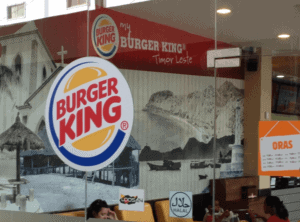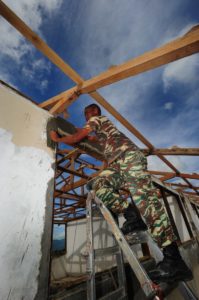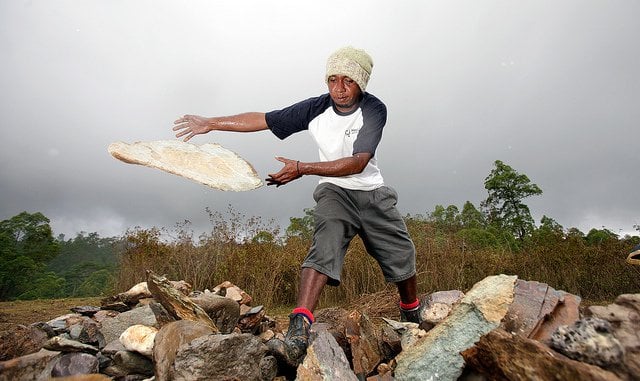It was rather surprising for me to see that Burger King was putting down roots in this small island country of East Timor (Timor-Leste). As an architect and traveler, I found this kind of foreign import highly fascinating. They are not only bringing the Whopper,1 but also a standardized production method, consumer service, dining atmosphere and experience. No such thoughts would have entered my mind when I walked into a Starbucks in Sydney or even Kyoto, but eating at a Burger King in Dili, East Timor was an experience so out of place.2
Burger King, albeit a prominent and novel presence of Americana, is a late-comer among the long line of foreign imports to East Timor. Many foreign influences have taken root here since the 16th century, when it became a Portuguese colony. (Take the two Cs, Catholicism and coffee trees, for example.)3
Since East-Timor’s independence from Indonesia in 2002, US, Chinese, and Australian businesses have planted their roots here.4 The most visible sign of this is the Timor Plaza Shopping Complex—East Timor’s first shopping mall, complete with a hotel, restaurants, supermarkets, a cinema, a microbrewery, and yes, one of the four Burger Kings.

Burger King in East Timor, photo taken by author
In contrast to these kinds of commercial interests and influences are those of foreign non-governmental (NGO) and religious organizations working here. As the needs are great, every year fleets of foreign volunteers come to assist and try to contribute their knowledge and expertise toward the nation-building of East Timor.
In April 2015, I became one of those longer-term foreigners working in East Timor (albeit a bit older and not quite as energetic as many of those foreign teenagers coming to paint classrooms). My religious superiors sent me to East Timor to help coordinate the design and construction projects of the Jesuits (a school, teacher training college, dormitory and health clinic).5
I often wonder whether my work has helped to grow ideas rooted in this country or been yet another foreign influence dictating how things should work here.
I have often asked myself, “What the heck am I doing here? Why is a local Timorese not doing this? Am I really helping at all?”
On the one hand, I know that I have skills and ideas to contribute. On the other hand, the very skills and ideas can be seen as an imposition if not used with a sensitive approach.
***
To me, there is little doubt that East Timor remains in need of international expertise in many areas of development. For example, visiting dentists or ophthalmologists can make a huge difference for those who normally lack access.
However, significant questions about the role of foreign experts and their relationship with the people whom they seek to help remain. Messiah complexes mixed with college students’ summer adventures are not always the best ingredients. The Instagram page, Barbie Savior, gives a pictorial and satirical account of such a mixture. It shows the similarities with another story of the effects of voluntourism on developing countries.
In looking at East Timor as part of the bigger global picture, then, how can foreign experts and voluntourists make effective contributions to the ideas, methods and capacities that the local people develop and take ownership of?
As much as there may be a need for foreign expertise, we also cannot deny that we foreign experts exert influence on the ways things work in the programs we implement locally. Even with the best of intentions, there is always a tension between local and foreign ideas and the methods with which to implement them. Surely, there are markedly different approaches between the United Nation’s World Food Program or Architecture Without Borders and that of Burger King. I suspect, however, that the differences aren’t always too far apart in terms of how foreign ideas and methods are disengaged from local ideas.
One example of this is prefabricated housing, which I noticed on my way to the easternmost point of East Timor late last year. This was part of the Timorese government’s 2011 Millennium Development Goals.6 In visiting this entire village of prefab houses about three years after the program was implemented, I saw quite a number of rundown, vacant houses. This left me to wonder whether the locals were consulted in the first place.
Granted, this is a government program and not a foreign NGO’s. And yes, some NGOs are doing great things for East Timor (and the government is, too, in some areas). One such NGO is the Timor Leste Dental Program, with which the Jesuits are collaborating.
Still, NGOs are not automatically off-the-hook. Good intentions can—and do—go wrong. Central to the work of international development should be helping to empower local people, especially the youth, to build their nation and national identity.
***
Architecture and the building profession play a significant role in nation-building, particularly in this young country of East Timor. More than just providing safe and comfortable shelter for people, architecture and building can give a sense of belonging to a culture, people and place. It is empowerment when the people can call schools, government buildings, and places of worship their own.
Not all buildings, however, are grounded in the local culture and place. Take, for example, a Burger King in East Timor.

Flickr CC photo from Australian Department of Defence
The primary role of foreign architects and building professionals is to help local users articulate their ideas and translate them into innovative and environmentally responsible buildings that the local people can build and maintain. I am heartened by stories like a dormitory for health care workers in Rwanda and a vocational school building and housing prototype in Cambodia (which is quite a different approach from that of the prefab village in East Timor). These are examples of a partnership between local ideas, capacity and materials, along with foreign expertise and innovation. The buildings ‘belong’ to where they are built.
Architecture should not be created as a consumer product for those who can afford it (i.e. an architect-designed building). Architecture (and design) that serves the public good plays an important role in nation-building.
All of the above are much easier said than done. I have yet to see a recently built public building in East Timor that entirely encapsulates the empowerment of its people. Instead, I have seen four Burger Kings.
Forging a national identity is difficult when a young nation is being assisted and influenced by so many foreign entities and people with diverse ideas and values.
While I and many others have tried to provide assistance to developing countries such as East Timor, I am weary of the idea that we-foreign-experts-know-best. In a long but comprehensive article on international development, “Stop Trying to Save the World,” Michael Hobbs points to examples of complicated foreign solutions that went wrong, including PlayPumps, “a merry-go-round hooked up to a water pump” operated by children to provide fresh water to rural villages in Sub-Saharan Africa.
I am not an expert in international development, but from my little experience here in East Timor, oftentimes the best solutions can be found locally. Best practices are invaluable in many contexts as there is no need to reinvent the wheel. However, we must remain open to adapt them to the local contexts and discover new best practices that grow out of this adaptation. A collaborative process should help to bring forth articulated localized solutions that the local people themselves can take ownership of.
For myself, the struggles have been the recurring questions. Where are the vernacular ideas in the buildings which I have helped build? How do the local Timorese see those buildings? Were the students able to learn better in those classrooms? Can they keep them well maintained? How can I engage and integrate the local ideas into innovative designs? Why haven’t I been able to change some of the project management, construction, and building maintenance practices? Some of these questions remain unanswerable. Perhaps different questions should have been asked.
***
In the course of my one-year assignment here in East Timor, I often wondered whether the ideas I have helped to become buildings were coming from what is rooted deeply in this country. I often wondered whether those building would eventually become, as difficult and challenging as it is, distinctively Timorese architecture.
I’m content in handing over the responsibilities to my Timorese collaborator. He will face challenges and discover opportunities. Most importantly, the nation he builds is his own.
As I am leaving East Timor, Jacob Kushner helps sum up my sentiment rather fittingly:
To many of these people, simply experiencing a foreign culture is not enough. They must change that place for the better. … I’ve come to believe that the first step toward making the world a better place is to simply experience that place.
For myself, I hope that my being here, and not so much what I have done, was enough to help enable others to make East Timor a better place.
I remain hopeful that users will benefit from and readapt the buildings I helped to design and build. They can continue to grow new ideas to express an architecture that is Timorese, in all its diversity. In the long run, it is not just about building buildings, but building communities of persons and a sense of belonging. It is about people making the world a better and more liveable place wherever they are.
One of the most valuable contributions foreign experts can offer in the work of nation-building is engendering a collaborative process that can build on diverse local values and traditions. This would be a distinctively different approach than that of importing a Burger King.
– // –
The cover photo of Domingus Asep Soares of Timor-Leste was provided by the Asian Development Bank on Flickr.
- Yes, most of the primary ingredients of the Whopper Meal is imported from Singapore. While I expected the Whopper I consumed was made to Burger King’s strict standard, I found the onion rings rather disappointing as there weren’t real onions in the rings. ↩
- Starbucks and McDonald’s in Japan would have Japanese on the menu and try to adapt to the local taste (of course, for a commercial purpose). To celebrate springtime in Japan, you can eat McDonald’s Sakura Teriyaki Egg Burger and drink Starbucks’ Sakura (Cherry Blossoms) Chocolate Latte. And, as an architect, I am fascinated by a Starbucks Coffee shop in Fukuoka, Japan, that was designed by a Japanese architect. So far, however, East Timor’s Burger King’s menu remains in English and most of the items are as American as any Burger King in the United States. ↩
- I would suspect that they are neither mutually dependent nor independent. Well, here’s a free thesis topic for the taking: the relationship between the growth of Catholicism and coffee in East Timor. You might want to narrow it down a bit more, though. ↩
- While the United States Dollar is the official currency of East Timor, it is rather difficult to ascertain the US interests in East Timor (other than the official statement). Perhaps, the US interests lie in policy as the USAid programs assist Timor in democratic progress, human rights and governance. At the same time, it seems that Australia remains interested in East Timor’s oil. It’s worth knowing that the United States (and then later Australia) gave tacit approval for Indonesia’s invasion of East Timor in December 1975 (the same year that ended the Vietnam war), which lead to 25 years of violence, occupation, and oppression that caused the death of about 200,000 Timorese. I note that this part of East Timor’s history should not be mentioned merely in a footnote. Hence, it would need a whole report to cover. ↩
- I wonder if any of you readers out there have been on a volunteer/mission/immersion trip that was not involved in helping to build a school (or educational facility or a building of some sort)? ↩
- Suco Program, part of the Programs of the Fifth Constitutional Government of Timor-Leste, 2012-2017, page 55. ↩


